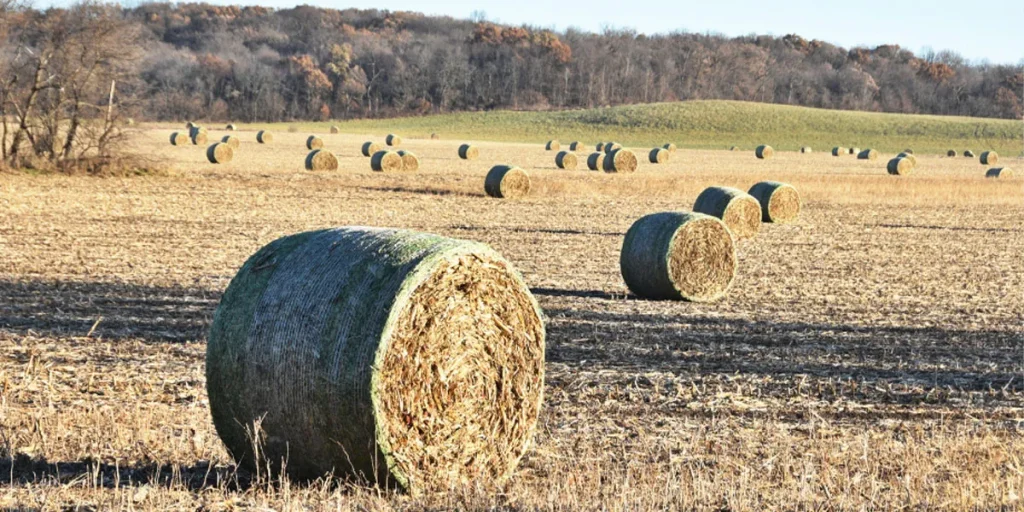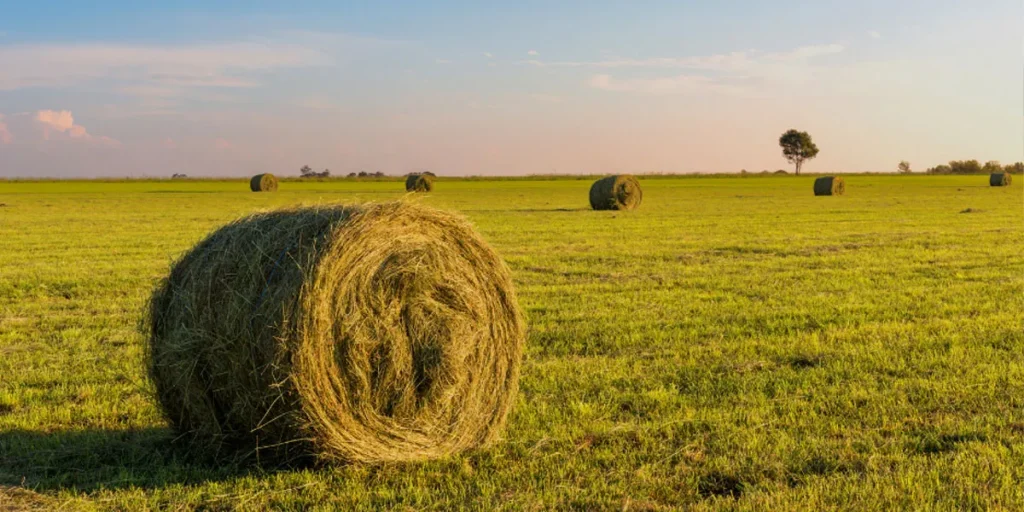A small bale of alfalfa typically weighs between 60 to 100 pounds. Large bales can range from 500 to 2,000 pounds.
Understanding the weight of alfalfa bales is crucial for farmers and buyers, as it impacts transportation logistics and feeding regimes.
Alfalfa, a nutrient-rich forage, is a principal feed for dairy cows, horses, and other livestock. Its weight can dictate the cost and quantity needed for proper animal nutrition.
Purchasers must consider the bale size and weight to estimate storage space and calculate shipment costs effectively.
Bale weight also varies with moisture content, packing density, and size dimensions, which are essential factors for anyone involved in the agriculture industry.
Handling alfalfa bales correctly ensures the preservation of their quality, making knowledge of their weight an agricultural necessity.
The Weight Of Alfalfa Bales
Understanding the weight of alfalfa bales is important for farmers and buyers. It influences transportation, storage, and feeding calculations.
A standard alfalfa bale’s weight can vary–but what factors contribute to this? This post delves into typical sizes and what affects their weight.
Typical Bale Sizes And Weights
Alfalfa bales come in various sizes. Each has a common weight range. Small square bales often used for ease of handling, typically weigh between 40 to 60 pounds.
For larger needs, large square bales can weigh from 800 to 1,200 pounds. Lastly, round bales, used for high-volume feeding, can tip the scales at about 1,000 to 2,000 pounds.
| Bale Type | Typical Weight |
|---|---|
| Small Square Bale | 40-60 pounds |
| Large Square Bale | 800-1,200 pounds |
| Round Bale | 1,000-2,000 pounds |
Factors Affecting Alfalfa Bale Weight
Many elements can change a bale’s weight. Moisture is a key factor. Wet alfalfa is heavier. Baling pressure also matters.
High pressure creates denser, heavier bales. Additionally, alfalfa’s maturity at baling influences weight. Younger plants are lighter than their mature counterparts. Here are the primary factors:
- Moisture Content
- Baling Pressure
- Alfalfa Maturity
- Bale Size and Shape
Each factor must be considered when determining an alfalfa bale’s weight. This knowledge helps in efficient farm management. Now, let’s explore each aspect in detail.
Farming Practices Impacting Alfalfa Bale Weight

When it comes to determining the weight of a bale of alfalfa, farming practices play a crucial role.
The harvesting techniques and the equipment used for baling can significantly impact the weight of each alfalfa bale produced on a farm.
Understanding these factors helps farmers optimize their yields and manage their operations effectively.
Harvesting Techniques
The method and timing of harvesting alfalfa are vital. Here are key points that affect bale weight:
- Maturity of Alfalfa: Younger plants are lighter, leading to lighter bales.
- Moisture Content: Dry alfalfa weighs less than alfalfa with higher moisture levels.
- Cutting Schedule: Frequency of cuts influences overall plant health and bale weight.
Baling Equipment Considerations
Different types of baling equipment can alter bale weight as follows:
| Baler Type | Weight Impact |
|---|---|
| Round Baler | Produces heavier bales due to size and compression. |
| Square Baler | Typically yields more consistent and lighter bales. |
| High-density Baler | Increased compression results in heavier bales of similar size. |
Finally, maintenance of baling equipment is essential to ensure consistent bale weight and quality.
Nutritional Value In Relation To Weight

Alfalfa bales are a crucial source of nutrition for livestock. The value they provide is not just in their physical size but also in their rich content.
A typical alfalfa bale can weigh between 50 to 150 pounds. The weight can affect how we view its nutritional richness.
Let’s look into why the combination of these aspects matters.
Nutrient Density
The term nutrient density refers to the concentration of vitamins and minerals in a feed relative to its weight.
Alfalfa, high in protein, calcium, and other essential nutrients, is often measured by this value.
Higher densities mean animals need to consume less to meet their nutritional requirements.
- High in vitamins A, E, and K
- Wealth of minerals including calcium and phosphorus
- Packed with plant proteins critical for growth
Effects Of Bale Weight On Feed Quality
Consideration for the weight of an alfalfa bale matters. As the weight increases, the chances of moisture and mold build-up inside can rise. This risk may lower the feed’s overall quality.
Lighter bales, on the other hand, may represent a fresher crop, with less compression and better preservation of nutrients.
Uniformity in bale weight across your supply can lead to more consistent feeding routines and nutrition for your animals.
| Bale Weight | Pros | Cons |
|---|---|---|
| Lighter (< 100lbs) |
|
|
| Heavier (> 100lbs) |
|
|
Understanding the relationship between bale weight and nutritional value is key. It ensures that your livestock receives the quality and quantity of alfalfa they need to flourish.
Transportation And Handling Of Alfalfa Bales
Understanding the transportation and handling of alfalfa bales is key for smooth agricultural operations.
These bales, packed with nutritious hay, are vital for livestock feed. Their size and weight raise important questions about the most efficient ways to move and manage them.
Logistical Challenges
- Weight variations affect vehicle capacity.
- Alfalfa bales must stay dry and intact during transit.
- Special equipment is often needed for loading and unloading.
- The distance of transportation can impact bale quality.
Cost Implications
| Factor | Influence on Cost |
|---|---|
| Bale Size & Weight | Fuel and possible overload fines |
| Distance | Longer distances mean higher fuel costs |
| Equipment | Rentals or purchases of forklifts or loaders |
| Labour | Costs for skilled operators and handlers |
Weight And Cost Considerations
Buying alfalfa requires understanding its weight and price. Alfalfa bales can vary in weight. This affects cost.
This section helps you make informed choices. Find out about pricing per pound or ton. Learn to evaluate true alfalfa costs.
Price Per Pound Or Ton
Alfalfa is often sold by weight. Knowing the price per pound or ton is crucial. Prices fluctuate based on factors like quality, availability, and location. Use this information to budget for your needs.
| Alfalfa Quality | Price per Pound | Price per Ton |
|---|---|---|
| Premium | $0.15 | $300 |
| Good | $0.13 | $260 |
| Fair | $0.10 | $200 |
Evaluating The True Cost Of Alfalfa
Looking at the price is just part of the story. Assessing true alfalfa costs means considering:
- Transportation – Delivery adds to the total cost.
- Storage – Proper storage is key to prevent waste.
- Waste Factor – Some bales have more waste than others.
- Nutrition Quality – Higher quality could mean better value.
- Yield – How much edible product you get is important.
Calculate these factors to get the real price of alfalfa for your situation. Consider buying in bulk to save money if it makes sense for you.
FAQ About the Weight of a Bale of Alfalfa
What Is The Average Weight Of An Alfalfa Bale?
A typical small square bale of alfalfa weighs around 60 pounds. Large round bales can weigh anywhere from 500 to 1,500 pounds, depending on size.
How Does Bale Size Affect Alfalfa Weight?
The size of the bale directly influences its weight. Small square bales usually range from 50 to 70 pounds.
Large round or square bales can vary greatly, often weighing over 1,000 pounds.
Can Alfalfa Bale Weight Vary By Season?
Yes, alfalfa bale weight can vary with seasons. Bales might be lighter in spring due to higher moisture content and denser, thus heavier, in drier conditions.
What Factors Influence The Weight Of Alfalfa Bales?
Several factors affect alfalfa bale weight, including moisture content, bale density, and the equipment used for baling.
Optimal moisture levels and compaction will result in a standard weight range.
Conclusion
Understanding the weight of a bale of alfalfa is crucial for proper storage, feeding, and transportation.
Typical bales range from 60 to 100 pounds, though this can vary based on moisture content and baling techniques.
Always check the specifics with your supplier to ensure you’re equipped for handling and usage.
Remember, getting the weight right makes all the difference for efficient alfalfa management.
Resources:
https://www.canr.msu.edu/news/large_round_bale_storage
https://extension.okstate.edu/fact-sheets/print-publications/bae/round-bale-hay-storage-bae-1716.pdf
